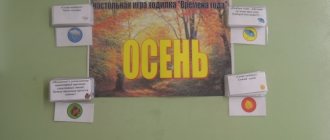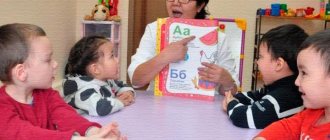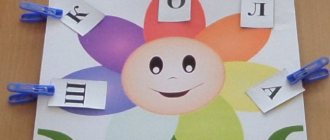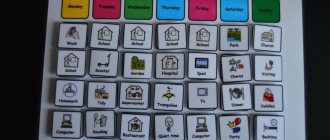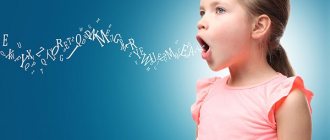Characteristics of a kindergarten student for PMPK
Information about parents:
Mother:
Place of work:
Education:
Father:
The child has been attending kindergarten since November 17, 2007. He came to the second junior group from the nursery group. I quickly got used to the new environment, because... I knew all the children. The boy attends kindergarten almost constantly and rarely gets sick. Relations with children are rather friendly, although there are often conflicts over toys. If a child likes a toy, or it is similar to toys that are in his home, then the child may mistakenly take it for his own and it is difficult to convince him otherwise. He gets offended by comments, turns away, may cry, and retires.
In the familiar setting of a kindergarten, the child independently follows the familiar rules of communication with adults and children. He almost always enters a group in a good mood: he says hello, says goodbye, asks for help in separate words, often pronouncing words incorrectly.
Speech development . Vocabulary is poor. A child’s speech consists of individual words, often incomprehensible to adults and children. The pupil rarely constructs sentences of three or four words, using only those words that he often uses: “I want to eat”, “My toy”. To achieve the desired result, teachers often have to repeat memorized words with the child; when repeating, the boy rearranges the sounds.
The child does not participate in the conversation, trying to turn away from the children. He cannot compose a story based on a plot picture, a set of pictures, retell short works, or compose a story based on a picture - he only names individual words, sometimes not even related to each other.
He has a very difficult time remembering poetry, cannot determine the place of a sound in a word, and sometimes does not understand what is being asked of him. To learn a couple of lines of a poem with a child, you need to put in a lot of effort, sometimes more than one day. When reading works, fairy tales, poems, nursery rhymes, the boy is distracted by foreign objects and often covers his ears with his hands, and at the very beginning of reading the work. When you ask him: “Why are you doing this?” answers “I’m tired, I want to play” knows that he is a boy, but at the same time speaks of himself in the feminine gender.
Mathematical representation . The child’s ordinal counting is within 10, he counts in forward order, but thinks for a long time in reverse (counts from the beginning and stops at the number that needs to be named). Counts items from a large quantity according to a pattern given by a number. When counting objects: distributes the figures on the table as they are located on the card (visually copying them, as shown in the sample). Places objects of various sizes in ascending and descending order, sometimes gets confused, notices mistakes and corrects them himself, asks the teacher (“Is that correct?”). Knows geometric shapes, but does not always name them correctly.
Does not define or express in words the location of the object to itself or other objects. The student does not know how to navigate on a sheet of paper, lining up all the geometric shapes in a line from top to bottom. Confuses the left and right sides, does not name the current day of the week, confuses the changing parts of the day, seasons. Knows primary colors, confuses white with brown, does not know shades.
Visual activity. The student shows interest in works of art and responds emotionally to beautiful things. He draws and sculpts on his own. Holds the brush and pencil correctly. When drawing the outline of an object with a simple pencil, he cannot control the pressure on the pencil, leaving rough lines. When working individually with a boy, the boy uses a variety of techniques in brush painting.
He does not know how to develop a plot in a drawing, depicting it in separate fragments, and often duplicates them.
Does not correlate objects and their parts by size, height, or location relative to each other.
Conveys in the image the basic properties of objects (shape, size), sometimes confuses the color, replacing it with another. Visually transfers images into drawings (copying - sketching). Upon completion of work, tidies up the workplace. For a long time he draws what he likes best (Spiderman, tank, etc.). Uses a variety of cutting techniques, but does not do it carefully. Doesn't always bring a plan to completion.
Uses plasticine, sculpts objects of different shapes, using learned techniques and methods. Doesn't always convey the proportions and poses of the figures.
Constructive activity. Plans to create his own building, creates buildings according to a drawing, according to a model, according to a diagram. The boy loves to use building material. The boy finds new constructive solutions and is happy when he is praised. It is not always possible for a child to work collectively: he takes the construction kit parts from the children, trying to independently create his own building. He is offended if they offer to combine his building with other children. May become stubborn and not take part in the future.
Game activity. The child’s favorite games: puzzles, construction sets, likes to draw and color. Willingly plays outdoor and didactic games, but does not always follow the rules of the game and turn. He is happy when he is put in leading roles, but does not always obey the rules in games, sometimes does not understand what is required of him: he is offended, and does not know how to negotiate with a partner. Rarely plays role-playing games with children and does not know how to coordinate his actions with the actions of his partners.
Fulfills the request of his elders and rejoices when he is praised. Shows him his favorite toys and books. Shows empathy towards adults and children.
Uses toys for their intended purpose. Treats his toys with care, neatly folds them and puts them in their places. He notices broken toys and brings them to an adult: “The toy is broken.” Plays the game he likes for a long time. He can put the toy he likes in his cubicle.
Physical development. Performs basic movements correctly. The child's coordination is not impaired. The boy eagerly turns on and masters new and varied movements. Actively and interestedly participates in outdoor games. Doesn't always keep up with the overall pace. When changing lanes, he gets confused and his sense of rhythm is disturbed.
Musical activity . Does not show interest in musical works, is often distracted, and interferes with children. Does not show independence in using songs, but if songs are often sung (in preparation for matinees) he sings.
The child is independent in self-care , knows how to use cutlery, quickly dresses and undresses, brushes his teeth independently, notices problems in his appearance, but does not always keep his closet in order (he throws things around, does not turn them inside out), folds his things when reminded, and is often stubborn .
For the full text of the material Characteristics of a kindergarten student for PMPK, see the downloadable file
. The page contains a fragment.
| Author: Stupnikova Tatyana Aleksandrovna → Publisher 09.18.2015 0 266016 8481 | Comment |
Thank you for your mark. If you want your name to be known to the author, log in to the site as a user and click Thank you again. Your name will appear on this page.
Login | Registration
Have an opinion? Leave a comment
Preview:
Psychological and pedagogical characteristics for a pupil of preschool educational institution No. ____
Typological features: 1. Active, mobile, sluggish, inert, slow. Excitable, unbalanced, calm, balanced, inhibited, whiny_________________________________ 2. Quick reaction to verbal stimuli, switchability.
___________________________________________________________________________________ 3. The predominant mood is cheerful, depressed, without any particular shade. Are there sharp fluctuations in mood during the day? __________________________________________ 4. Does he persist in the face of difficulties or retreat in the face of them. Does he ask for help and use it?__________________________________________ Characteristic features: 1. Sociability, isolation. Easily makes contact, correctly perceives the situation, understands its meaning, behaves adequately, contact and communication are difficult, understanding and responding to the situation is not always or not entirely adequate, does not make contact well, has difficulty communicating and understanding the situation. 2. Attitude towards comrades - friendliness, negativism, kindness, rudeness, etc. 3. Attitude towards leadership - the desire for primacy, whether others recognize the leader. Does he show organizational skills and initiative? 4. Attitude towards adults. Attitude to instructions, rewards, reprimands________________ ___________________________________________________________________________________. 5. What types of activities does he prefer? ________________________________________________ 6. The activity of verbal communication is age-appropriate, increased, decreased, isolation and a negative attitude towards verbal communication are noted. 7. Behavior is organized, sometimes does not regulate one’s behavior, constant external control is required. Psychological features: 1. Auditory memorization, visual memorization, tactile memorization. Remembers quickly or slowly, with difficulty, transition to long-term memory, the amount of RAM is sufficient, limited, low. 2. Stability of attention - capable of long-term concentration or easily distracted. Nature of distraction – distracted by stimuli, in the absence of external stimuli. 3. Switching of attention - easy, fast, slow, difficult. 4. Distribution of attention – sufficient, difficult. 5. General level of attention development – appropriate for age, low, not formed. Level of development of mental activity: 1. The ability to compare, classify, generalize, the ability to identify an essential feature of objects, phenomena.__________________________________________________________________ 2. the ability to use techniques for memorization - indirection, grouping, associations. Development of sensory functions: 1. The state of the analyzers, the presence of generalizing ideas about shape, size, color, the concept of relativity - corresponds to age, is not formed, is impaired.
Development of imagination: 1. Brightness, liveliness, richness of imagination, ability to operate with images, in what types of activities it is manifested (music, arts, mathematics, physical education, speech, design, etc.) - appropriate to age, excessively, weakness of imagination processes. Verbal part: 1. Understanding stories, ability to answer questions based on the text___________________________ 2. Retelling.__________________________________________________________________________. 3. Plot storytelling _________________________________________________________________ 4. Ability to work in dialogue mode._________________________________________________________ 5. Speech activity - adequate to the situation and age, excessive, difficulties initiating a speech utterance, emotional inadequacy, problems with detailed speech, difficulties in sound pronunciation, presence of stuttering, etc._______________________________________________ Performance in the classroom: 1. Attitude is active, interested, indifferent. 2. Concentrated or often distracted during class. 3. Quickly or slowly starts working. 4. The pace of work is fast, medium, slow. The reasons for the slow pace of work are thinking, careful execution, decreased mental activity - lethargy, lethargy, distractibility, etc. 5. Fatigue manifests itself in a slowdown in pace, deterioration in quality, or complete cessation of work. 6. Subjective and objective signs of fatigue - complaints of fatigue, headache, lethargy, drowsiness, distractibility, etc. 7. Decline in performance in the middle of a lesson, at the end of a lesson. 8. The ability to follow instructions, the ability to retain instructions for the duration of _________________________________________________________________________________. Arbitrariness of activity: 1. Maintains the goal of the activity, outlines its plan, selects adequate means, checks the result, and brings the work started to completion. 2. In the process of activity, he is often distracted, overcomes difficulties only with psychological support, and needs frequent encouragement. 3. The activity is chaotic, ill-conceived, individual conditions of the task are lost, the result is not checked, the activity is interrupted due to difficulties, help is ineffective.
Somatic health: a) rarely gets sick; b) often suffers from colds; c) has chronic diseases; d) poor appetite; e) takes a long time to fall asleep and sleeps restlessly; f) other________________________________________________________________________________
General assessment of the child’s level of development and behavior:________________________________________________________________________________________________________________________________________________________________________________________________________________________________________________
Group teacher ________________________________________________________________ date _________________
Psychological and pedagogical presentation at PMPC
(for a preschool child)
Date of completion: _____________________ 20__
Last name, first name, patronymic of the child ________________________________________________________________________________
Date of birth "___"_________________
Duration of stay in this preschool educational institution ________________________________________________
At what age did you enter _____________________________________________________
Where did you come from: from family, from another preschool educational institution (reason for transfer)
Assessment of the child’s adaptation in the group: a) good; b) satisfactory; c) insufficient; d) bad; e) other_____________________________________________
Features of lateralization: a) right-handed; 6) left-handed
Features of gaming activities: a) games are age appropriate; b) games are appropriate for an earlier age; c) manipulative games predominate; d) there is no gaming activity; e) other_______________________________________________
The main difficulties noted in training: a) masters the program well; b) masters the program satisfactorily; c) has difficulty mastering the program; d) does not master the program; e) other_______________________________________________
Perception: a) corresponds to age; b) there are visual impairments; c) there are impairments in auditory perception; d) complex perception disorders; e) other__________________________________________________________
Attention: a) steady; b) not stable enough; c) unstable
Memory (predominant modality): a) visual; b) auditory; c) motor; d) mixed
Memory features (problems): a) without pronounced features; b) remembers slowly and forgets quickly; c) quickly remembers and quickly forgets; d) other problems_______________________________________________________________
Thinking: a) appropriate for age; b) not smart enough; c) has obvious thinking disorders (specify which ones) ________________________________
Motor skills: a) corresponds to age; b) the child is awkward, clumsy; c) poorly developed fine motor skills; d) other_______________________________________________________________
Main difficulties in communication: a) no difficulties; b) does not know how to support the game; c) prefers to be alone; d) cries, does not make contact with adults, children e) is conflicted; f)other________________________________________________
Speech development: a) speech corresponds to age; b) speech is slurred; there are difficulties in pronouncing sounds; c) poor vocabulary; d) the speech is grammatically incorrect; e) hesitations in speech; f) there is no speech; g) other_______________________________________
Social skills: a) appropriate for age; b) insufficiently formed; c) practically not formed; d) other__________________________
Orientation in space and time: a) corresponds to age; b) insufficiently formed; c) there are violations (specify what ________ _________
Attitude to activities, features of activity: a) appropriate for age; b) is unable to control his activities; c) restless, does not complete the task; d) interferes with the teacher and children; e) gets tired quickly; f) other_________________
Pace of activity: a) appropriate for age; b) drowsy and lethargic during the day; c) the pace of work in classes is uneven; d) works slowly and inattentively; e) the pace of activity is fast, but the activity is “chaotic and stupid”; f) other___________
Somatic health: a) rarely gets sick; b) often suffers from colds; c) has chronic diseases; d) poor appetite; e) takes a long time to fall asleep and sleeps restlessly; f) other__________________________________________________________
Other features of child development:________________________________________________
General assessment of the child’s level of development and behavior, teacher suggestions:
Psychological-Medical-Pedagogical Commission (PMPC)
Many parents are frightened by the PMPK (Psychological-Medical-Pedagogical Commission), because they do not fully understand the essence of this commission, why their child needs it, and also not all parents are ready to accept information that their child needs help. In addition, there are many different stories circulating on the Internet where members of the commission behaved inappropriately towards a child and parent, and also made incorrect decisions. Let's take a closer look at the essence of the PMPC, the algorithms for conducting the commission and the consequences of the commission's conclusion.
WHAT IS THE PMPK AND WHAT DOES THE COMMISSION DO?
PMPK is a psychological, medical and pedagogical commission that evaluates the comprehensive health of the child and, based on the assessment results, gives a conclusion that contains conclusions about the presence or absence of the child’s physical and mental development characteristics, behavioral abnormalities, as well as a list of recommendations, which will help to comprehensively correct these violations.
The main goals of the commission in accordance with Federal Law No. 273-FZ “On Education” dated December 29, 2012 are:
- Conducting a comprehensive psychological, medical and pedagogical examination of children in order to timely identify features in the physical and (or) mental development and (or) deviations in the behavior of children;
- preparation, based on the results of the examination of children, of recommendations for providing them with psychological, medical and pedagogical assistance and organizing their education and upbringing;
- confirmation, clarification or change of previously given recommendations.
In addition, in the Order of the Ministry of Education and Science of the Russian Federation dated September 20, 2013. No. 1082 “On approval of the regulations on the Psychological-Medical-Pedagogical Commission” defines the main areas of activity of the PMPK
.
WHO IS INCLUDED IN THE PMPC?
In addition to these specialists, other specialists may be invited, in agreement with the executive authority of the subject or local government body.
The examination of children is carried out by each specialist of the commission individually or by several specialists simultaneously. The composition of the commission specialists participating in the examination, the procedure and duration of the examination are determined based on the objectives of the examination, as well as the age, psychophysical and other individual characteristics of the children.
FOR WHOM IS PMPK CONDUCTED?
- Children;
- Students with disabilities;
- Disabled children.
ON WHOSE INITIATIVE IS THE PMPK CONDUCTED?
PMPK is carried out upon a written application from parents (legal representatives) or in the direction of :
- organization providing social services,
- medical organizations,
- educational organization,
- psychological-medical-pedagogical council,
- public organization
with the written consent of parents (legal representatives).
In addition, when examining children over 15 years of age, their consent is required for the examination.
WHAT IS THE ALGORITHM FOR CONDUCTING PMPK?
Parents (legal representatives) provide a package of accompanying documents to the commission, and the commission examines them.
The child is examined by each specialist separately or jointly by several specialists at once.
A conversation is held with the child, and the child may also be asked to perform some tasks that will help assess the child’s psychological state and its suitability for age.
The results are discussed (without the child) and a conclusion is made.
WHAT TO DO IF A PARENT (LEGAL REPRESENTATIVE) DISAGREES WITH THE RESULTS AND WHERE TO APPEAL THE RESULTS OF THE PMPK?
The conclusion of the PMPK is mandatory for an educational organization and if the organization does not have educational programs or the necessary conditions specified in the conclusion, then the executive or local government body that manages the field of education together with the educational organization is obliged to create on the basis of such a conclusion such conditions.
For the parents (legal representatives) of the child, the conclusion is of a recommendatory nature . The parent himself makes the decision whether to use these recommendations, but it should be understood that the recommendations are aimed at ensuring that the child can receive education in the form and using methods that are most suitable for him, and will help compensate for developmental disorders, as well as to correct child behavior with the help of psychological and pedagogical assistance.
In case of disagreement with the conclusion of the territorial commission, if the parent believes that the recommendations issued based on the results of the PMPC do not reflect the interests of the child, the parent has the right to appeal it to the central commission . In turn, the decision of the central commission can be appealed to the court .
Similar
Spread the love

